In The Battles of the Great War - 1919
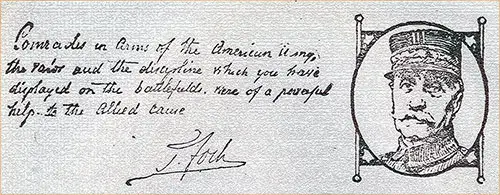
Comrades in Arms of the American Army, the Valor, and the Discipline Which You Have Displayed on the Battlefields Were of a Powerful Help to the Allied Cause. Signed by Marechal Foch. GGA Image ID # 17ebc81c59
All That We Have
By March 1913, the period of waiting was almost at an end. Secretary of War Baker, after an inspection of al! the work in France, declared:
"I find the boys in splendid condition and splendid spirits. I have been from factory to farm, now I am on the frontier of freedom."
Everywhere he heard of the daring and the bravery of the American soldiers. Their praises were sung by the French officers who, both in the United States and in France, had assisted in their training.
Meanwhile, the Germans had brought up eighty-five fresh divisions and launched a formidable attack. By March 25, they had driven the British back over the Somme. Ham, Péronne, Combles were in the hands of the enemy, who was only one hundred miles from Paris. The fighting in the French sector, near Noyon, was of unprecedented violence. The situation had become exceedingly serious.
On March 28, two days after Foch had been made Generalissimo in supreme command of all the forces on the western front, General Pershing made him the following declaration:
"I have come to tell you that the American people would consider it a great honor for our troops to be engaged in the present battle. I ask you for this in their name and my own. Infantry, artillery, airplanes, all that we have is yours. Use it as you wish. More will come in numbers equal to requirement. I have come particularly to tell you that the American people will be proud to take part in the greatest and finest battle of history."
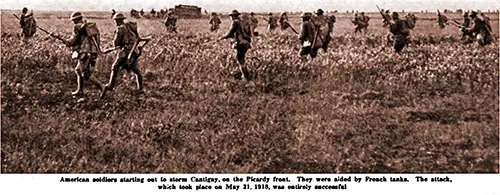
American Soldiers Starting out to Storm Cantigny, on the Picardie Front. They Were Sided by French Tanks. the Attack Which Took Place on May 21, 1018, Was Entirely Successful. The Story of the Great War, Volume 14, 1919. GGA Image ID # 17ec30c988
Cantigny
With the clear foresight, which was one of the determining factors of the final victory, General Pershing had insisted from the beginning upon the development of a "self-reliant infantry, thoroughly drilled in the use of the rifle and in the tactics of open warfare."
He had reason to be proud when, on the morning of May 28, the 1st Division went into action. On a front 2,000 yards wide, they pushed forward in less than a quarter of an hour to a depth of 1,800 feet; they made 300 prisoners. They seized the village of Cantigny and all other objectives and held them against severe counter-attacks.
Compared to the activities of the French and British, this combat, on a front extending from Verdun to the sea, was of minor importance. The news of the brilliant dash with which it had been executed spread like wildfire. It was a revelation of what no one had dared to hope: the Americans were warriors. Their fighting spirit could not be surpassed.
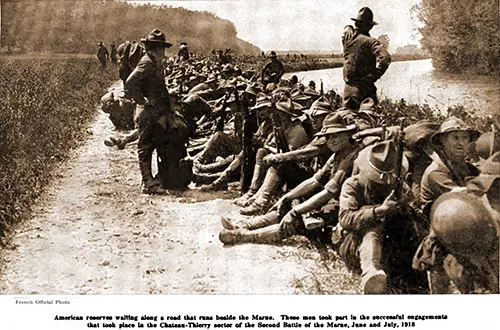
American Reserves Waiting along a Road That Runs beside the Marne. These Men Took Part in the Successful Engagements That Took Place in the Château-Thierry Sector of the Second Battle of the Marne, June and July 1918. French Official Photo. The Story of the Great War, Volume 14, 1919. GGA Image ID # 17ec3d83b1
Château-Thierry
The German offensive had meanwhile turned its fury upon the Aisne, with Paris as objective. Again, every available man was placed at the disposal of Maréchal Foch. The 3rd Division, fresh from its preliminary training in the trenches, was rushed with all speed to the Marne. Its machine gun battalion, pushing on ahead to meet this call, successfully held the bridgehead opposite Château-Thierry. The French order of the day, referring to this action, reads:
"The courage of the Americans was beyond all praise. The Colonials themselves, though accustomed to acts of heroism, were struck by the wonderful morale in the face of fire and the extraordinary cool-headedness of their Allies. The episode of Château-Thierry will remain as one of the brilliant pages of the war."
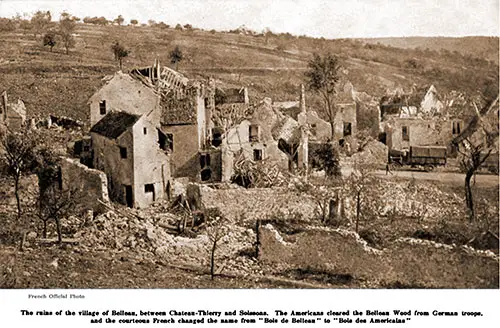
The Ruins of the Village of Belleau, between Château-Thierry and Soissons. the Americans Cleared the Belleau Wood from German Troops and the Courteous French Changed the Name from “Bois De Belleau” to “Bois Des Americains.” French Official Photo. The Story of the Great War, Volume 14, 1919. GGA Image ID # 17ec4939c9
Bouresches, Belleau Wood, Vaux
The 2nd Division, which had been in reserve near Montdidier, was sent simultaneously by every available means of transport to help in the effort to hold back the enemy, who with increasing forces was bearing down upon Paris.
On June 6, against the best German guard divisions, the Marines led a charge which, by midnight, had ended in the capture of the village and railroad station of Bouresches.
The next objective was Belleau Wood, a point of vital importance. In this attack, the conduct of the 4th Brigade of the 2nd Division was so brilliant, in combat with a numerous and ferocious enemy, that after the capture of Belleau Wood, the General commanding the 6th French Array decided it should henceforth be called "Marine Brigade Wood."
The French 6th Array cited the 3rd Brigade of Marines as having given a "superb example of dash, abnegation and sacrifice," and as having taken an important part in the victorious attack which led to the evacuation of French territory and which forced the enemy to solicit an armistice.
Though the 2nd Division had been fighting steadily for over two weeks, it was able, before being relieved, to seize the village of Vaux, in an offensive so perfectly planned and carried out with such precision that it was described by the French as "destined to remain a model of its kind".
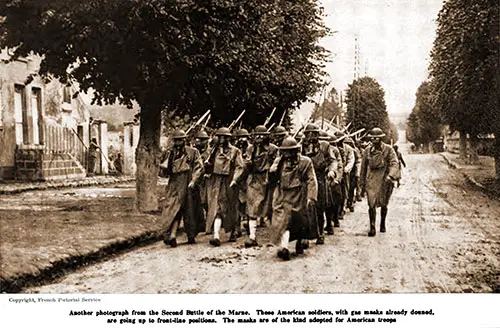
Another Photograph from the Second Battle of the Marne. These American Soldiers with Gas Masks Already Donned Are Going up to Front-line Positions. the Masks Are of the Kind Adopted for American Troops. Photo © French Pictorial Service. The Story of the Great War, Volume 14, 1919. GGA Image ID # 17ec615ad8
The Second Battle of the Marne
On July 15, after a pause for reorganization, the enemy launched a formidable onslaught from Château-Thierry to the Argonne. It was to be the last. Within forty-eight hours, the Allies had broken this offensive. The six American divisions thrown along the Marne did their large share in checking the German advance.
On July 18, in the thrust toward Soissons, the place of honor was given to the 1st and 2nd American Divisions, in company with French troops chosen for their prestige on the battlefield. By the first days of August, the Marne salient, into which the enemy had imprudently driven hundreds of thousands of his best troops, had been completely wiped out.
The French General, Mangin, who directed this offensive, when success had been attained, addressed as follows the American troops who had been under his command:
"You threw yourselves into the counter-offensive, and your indomitable tenacity stopped the counter-attack. I am grateful to you for the blood you have so generously shed on the soil of my country. I am proud of having commanded you during such splendid days and to have fought with you for the deliverance of the world."
General Pershing in Command
On August 10, the First Army was organized under the personal command of General Pershing.
In view of the important part the Americans were now to play, it was necessary for them to take over a permanent portion of the line that extended from east of the Moselle River to Verdun.
The operations in this sector resulted in signal success:
- On September 12, the First Army wiped out the Saint Mihiel salient.
- It released the inhabitants of many villages, took 16,000 prisoners, 443 guns, a great quantity of material.
- It established the new lines in a position to threaten Metz.
The power of the American Army had asserted itself. The gratitude of the French to the Commander-in-Chief was threefold: for his foresight in planning from the first for an army of millions, for his judgment in realizing that his soldiers must exercise themselves not in trenches, but in a war of movement, and for his character, so essentially American, which in the most critical moments laid aside all questions of personal vanity, in a disinterested determination that the cause, for which his men were giving their lives, should triumph.
The young American Army has been fortunate in possessing, among its historians, the great-grandson of Lafayette. In his American Army in the European Conflict, he relates the brilliant exploits of which he was himself a witness on September 12. "They were", he writes, "inspiring for the men, the officers and the chiefs of the entire Expeditionary Forces."
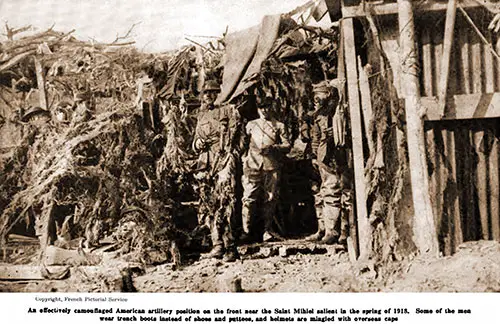
An Effective Camouflaged American Artillery Position on the Front near the Saint Mihiel Salient in the Spring of 1918. Some of the Men Wear Trench Boots instead of Shoes and Puttices and Helmets Are Mingled with Overseas Caps. Photo © French Pictorial Service. The Story of the Great War, Volume 14, 1919. GGA Image ID # 17ec794681
The Meuse Argonne Offensive
Twelve days later, hostilities were to be resumed on a much larger scale: at daybreak, on September 26, a barrage fire which for eleven hours illuminated the sky announced that the American offensive had been launched, between the Argonne Forest and the Meuse river.
This battle—one of the most important operations of the war—was to continue until the enemy capitulated. The objectives assigned to General Pershing’s Army were of paramount importance.
The Germans realized that if they could not hold their communication line at this point, all would be lost for them. They consequently withdrew division after division from the north to fling them in desperation against the Americans.
Out of nine divisions that took part in this brilliant attack, sustained for 47 days, only three were in possession of their organic artillery or had ever taken part in an active war, and five divisions came in contact with their artillery for the first time on the battlefield.
Two divisions had spent about sixty days in calm sectors; one had been ten, another sixteen days in the trenches, two had never been under fire. They were provided with only three quarters the regulation number of horses and wagons.
The natural difficulties they had to face seemed insurmountable. Yet despite roads heavy with mud, deep ravines, thick woods, and steep hills, the Americans pushed steadily on. Not at any time superior in numbers to the enemy, during this long struggle, they always had the upper hand.
On October 26, at the end of the first month, the troops had made an average advance of 10 miles on a 20-mile front, they had freed 45 villages from the Argonne to the Meuse, they had liberated 200 square miles of territory and they had penetrated the four strongest German systems of trenches, including the Hindenburg line. The aviators had shot down 230 airplanes and 20 balloons.
The gains from November 1 to November 5 brought the Americans to within 5 miles of the Metz-Sedan railroad, one of the two main lines connecting France with Germany. Five days before the armistice was signed. Maréchal Foch sent General Pershing the following message:
“Operations since November 1, by the First American Army, have already assured, thanks to tire valor “of the High Command, and to the energy and the “bravery of the troops, results of the greatest importance. I am happy to offer you my warmest congratulations on the success of these operations.”
Fifteen out of the twenty-two divisions engaged had been twice in action during the Meuse Argonne battle, in which the Americans sustained 100,000 casualties.
B. Van Vorst, "To The Homeward Bound Americans: In The Battles of the Great War," University of Virginia, 1919. Pamphlet included in "European War 1917-1818 Pamphlets, Vol. 67.
